

Talking about defoamers is always a headache, often inseparable from the discussion of “critical compatibility”. Therefore, Tiggo Additive brings high-performance defoamer Tech-365W, which achieves multi-dimensional defoaming throughout the entire process through hydrophobic particle synergy and ultrafine emulsification technology.
The critical compatibility of defoamers refers to their ability to achieve optimal defoaming performance while avoiding negative side effects such as turbidity, shrinkage, fish eyes, etc. They are neither excessively compatible nor excessively incompatible. There are many complex and ever-changing influencing factors involved in this, making it difficult for “defoaming” to make a decision.
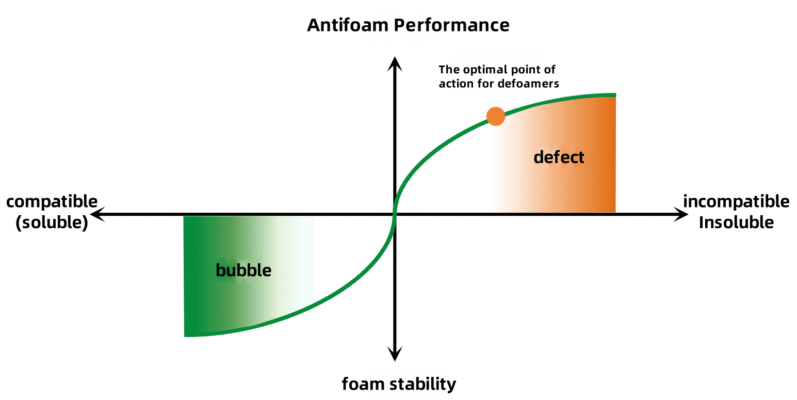
From an application perspective, whether a specific polysiloxane is used as a stabilizer or defoamer depends on its compatibility and solubility in liquid media. Only those polysiloxanes that are incompatible and insoluble in the medium can exert defoaming effects.
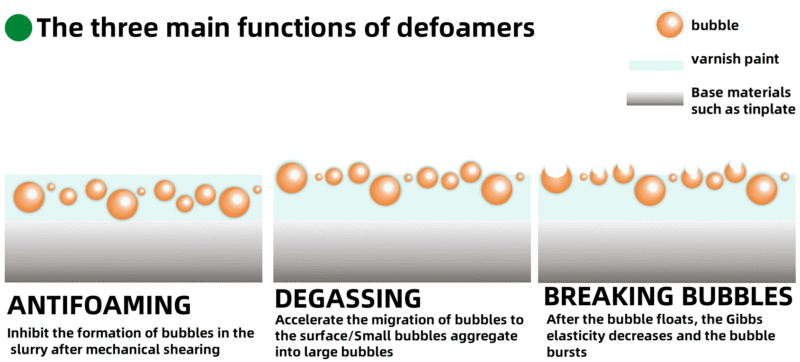
From a molecular structure perspective, the core structure of organosilicon defoamers is polydimethylsiloxane (PDMS) main chain, with methyl (CH3) groups and modified groups as side chains. The main controlling factors are molecular weight, chain length, and modified segments. Polysiloxanes with different molecular weights in the same system have different performances. For example, in a specific structure, products with low molecular weights may act as foam stabilizers, while homologues with high molecular weights can play a defoaming role due to sufficient incompatibility, and products with higher molecular weights (such as hammering agents) are completely incompatible.
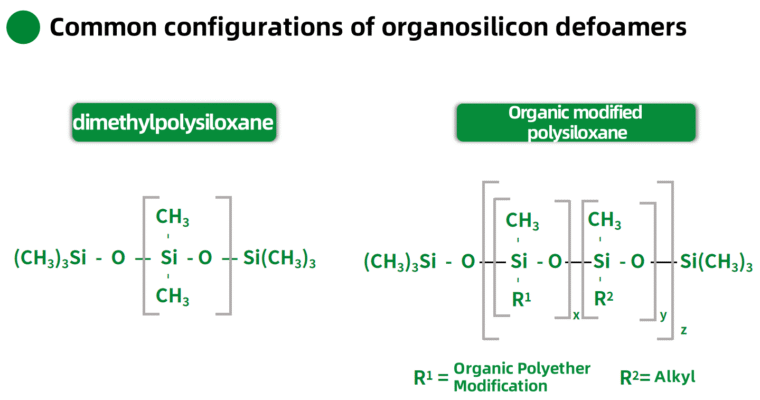
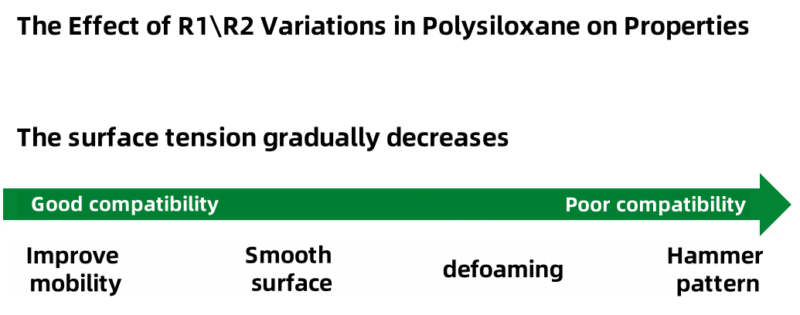
For the same defoamer, different polar systems have different compatibility and effects (as shown in the figure). For example, water-based defoamers with specific structures can provide a smooth surface in solvent based systems.
Normal bubbles: After forming in the liquid phase, bubbles are driven upward by buoyancy, and their rising rate (v) is proportional to the square of the bubble radius (r ²) and inversely proportional to the viscosity of the liquid phase (η).
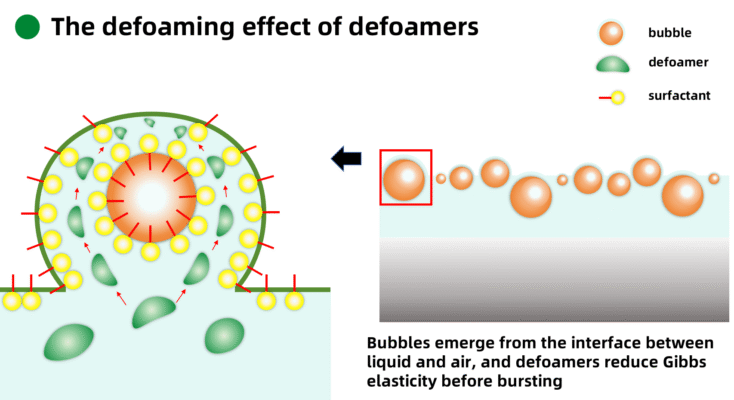
When bubbles reach the gas-liquid interface of the slurry, the bubble film undergoes continuous drainage under the synergistic action of gravity and capillary action, resulting in a nonlinear attenuation of the film wall thickness. Under normal circumstances, when the bubble film thickness drops to about 10 nanometers, the liquid film will rupture. What exactly causes stable bubbles?
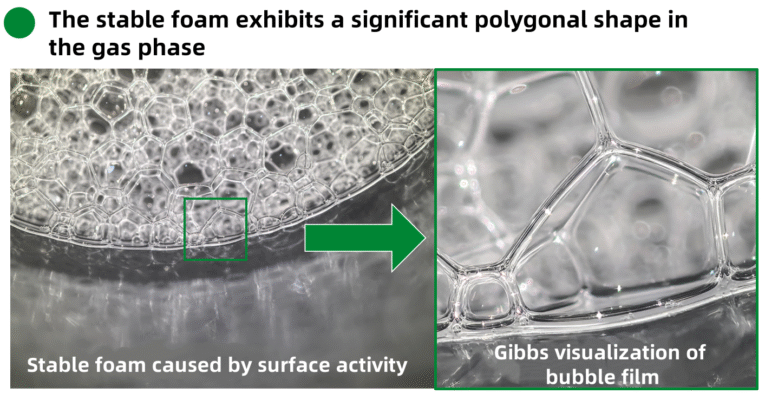
It is a surfactant. Surface active molecules are composed of hydrophilic and hydrophobic groups. When excess surface active molecules adsorb onto the bubble liquid film, the hydrophobic groups face the air and the hydrophilic groups extend into the water, forming a tightly arranged bilayer film at the gas-liquid interface. This film repairs the thickness of the liquid film and forms stable bubbles. Specifically, it is manifested as: a decrease in surfactant concentration in the thinning area → an increase in local surface tension → migration of liquid and surfactants from the surrounding high concentration area to the thinning area (Marangoni effect), repairing the thickness of the liquid film.
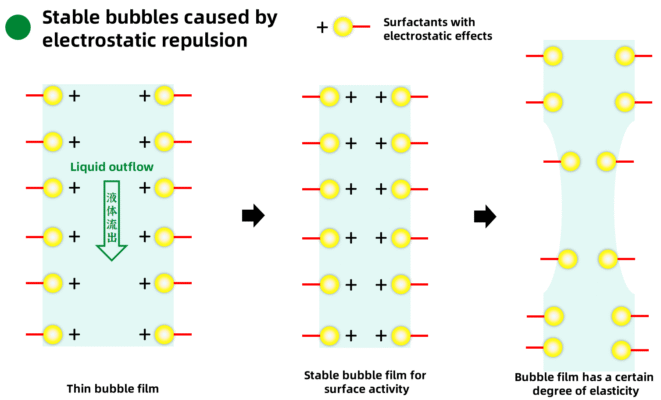
Uniform substances do not undergo stable foaming, and defoaming essentially means “breaking the membrane structure”. Its main method is to reduce the Gibbs elasticity of the bubble membrane (the ability of the liquid film to resist deformation) E=2A · d γ/da.
Defoamery and compatibility are not completely opposite. “Multidimensional defoaming” is an important way to improve the effectiveness of defoaming, and it is also an excellent solution for defoaming at present. It can achieve stable and unified defoaming effects under different process conditions and different addition amounts. Taking Tech-365W defoamer as an example, this product has multi-dimensional defoaming performance for pulp and wet film:
A、 Hydrophobic particle SiO2
The “hydrophobic particle SiO2” introduced in the Tech-365W water-based defoamer, polysiloxane and hydrophobic particles play a synergistic effect, making the foam unstable by reducing the cohesion, thus breaking the foam. Suitable for eliminating the foam stabilization caused by excessive surfactants such as dispersants, emulsifiers, etc.
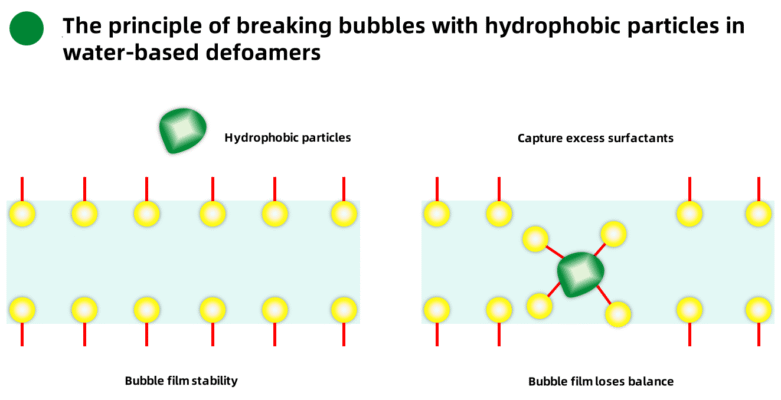
B、 Ultra fine emulsification technology
The Tiggo Tech-365W adopts ultrafine emulsification technology, which means a uniform and unified defoaming experience. It has significant dispersion/diffusion properties when used, and the small particle size gives the defoamer stronger Brownian motion ability, allowing it to quickly migrate to the gas-liquid interface, shorten the bubble breaking response time, and achieve significant instantaneous bubble breaking effect.
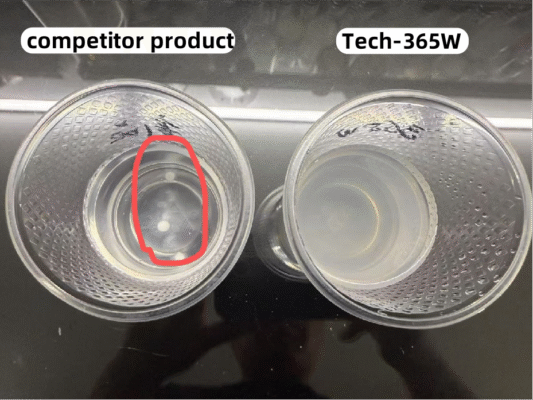
Competitor (left), Taige Additive Tech-365W (right)
Comparison of diffusion properties when dropped into water
C、Ultra wide positive entry coefficient
The “multidimensional” defoaming of Tech-365W can maintain a positive entry coefficient (E>0) for Gibbs film at all times, whether in different system slurries such as acrylic acid and polyurethane, or during the polarity change process of coating drying. This means that it can play a defoaming role throughout the entire process, and this characteristic also improves its instantaneous and continuous defoaming in flash dry coatings and thick coating. The specific process of action is mainly divided into two steps:
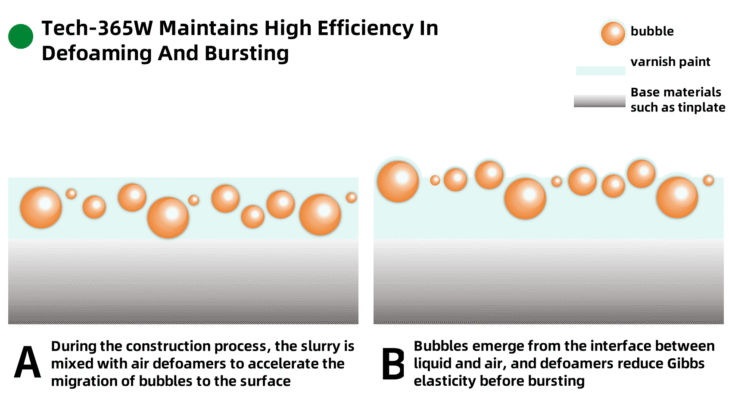
During the construction phase (as shown in Figure A), when the slurry is mixed with air to form bubbles, Tech-365W uniform super emulsified particles quickly penetrate into the bilayer of the bubble membrane, disrupting the stability of the liquid film, reducing microbubbles and increasing bubbles, and promoting rapid defoaming; Drying stage (as shown in Figure B):
The hydrophobic particles of Tech-365W defoamer, in conjunction with super emulsified particles, quickly enter the bilayer of bubbles, adsorb excess foam stabilizing substances, reduce the Gibbs elasticity of bubbles, and rapidly break bubbles.
D、Control of foam inhibition
Thanks to ultrafine emulsification technology, Tech-365W exhibits excellent anti foaming effect in liquid phase, without affecting glossiness and transparency after dry film. Compared to conventional products on the market, Tech-365W exhibits better compatibility in various systems, significantly reducing the risk of shrinkage and haze, and having minimal impact on coating gloss. Safe and environmentally friendly, with no VOC emissions.
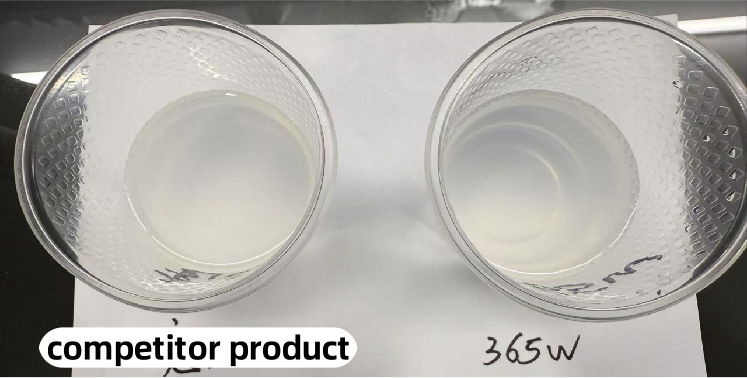
Competitor (left), Taige Additive Tech-365W (right)
Comparative testing of water compatibility
E、Instantaneous defoaming property
We conducted parallel tests in aqueous acrylic acid system, aqueous epoxy system and aqueous hydroxyacrylic acid two-component system, compared with the same type of defoamer on the market (0.2% added), observed the foam height immediately after 25 minutes of shock, and recorded the instant defoaming effect. The experimental results show that Tech-365W exhibits excellent instantaneous defoaming performance.
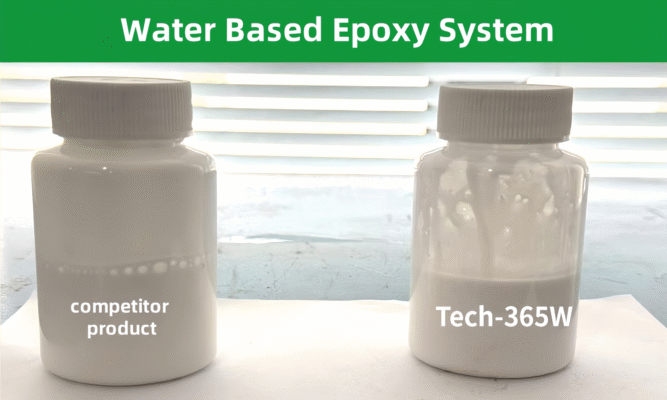
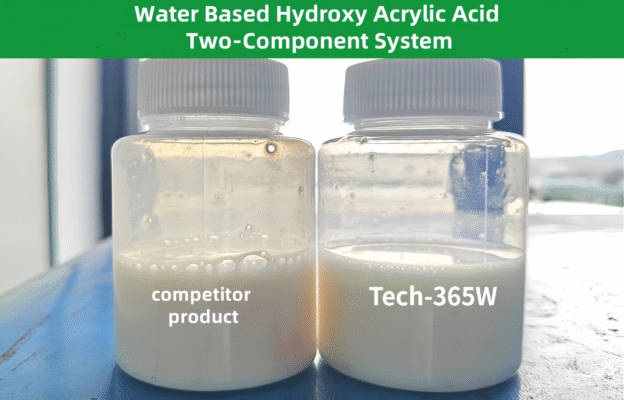
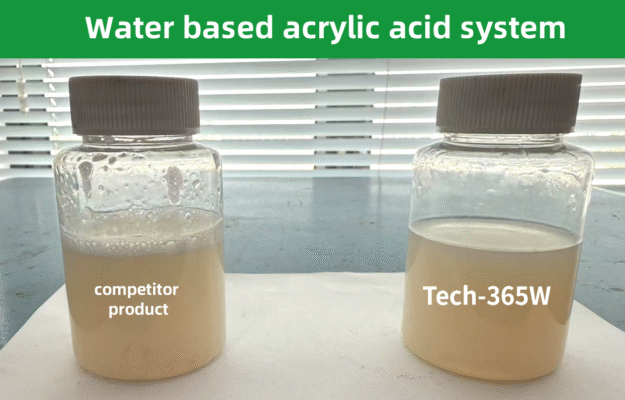
Tech-365W Multi Dimensional Defoamer is a leading defoaming solution in the industry, with an ultra wide positive entry coefficient that ensures defoaming throughout the entire process. It also has good instantaneous defoaming performance, avoiding the impact of dryness caused by temperature changes on defoaming performance and greatly reducing the occurrence of shrinkage caused by excessive use of traditional defoamers. Tech-365W is commonly used in varnish and paint formulations, suitable for airless spraying and spray coating, especially in high-end coatings, high-end inks, and polymer synthesis fields that require strict surface integrity.
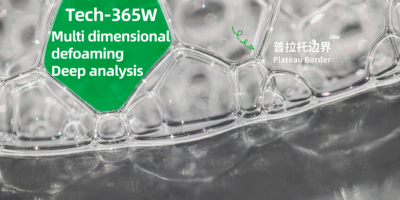
Deep analysis of Tech-365W’s “multidimensional defoaming”

Full process solution for automotive repair paint (formula practical version)

Tech-6752: A New Breakthrough in Dispersion Technology for Transparent Iron Oxide Nanopaste

New Tech-5366: A New Height in Stable Inorganic Materials

Tech-2550 true mirror leveling (excluding PFAS), no need for complicated compounding